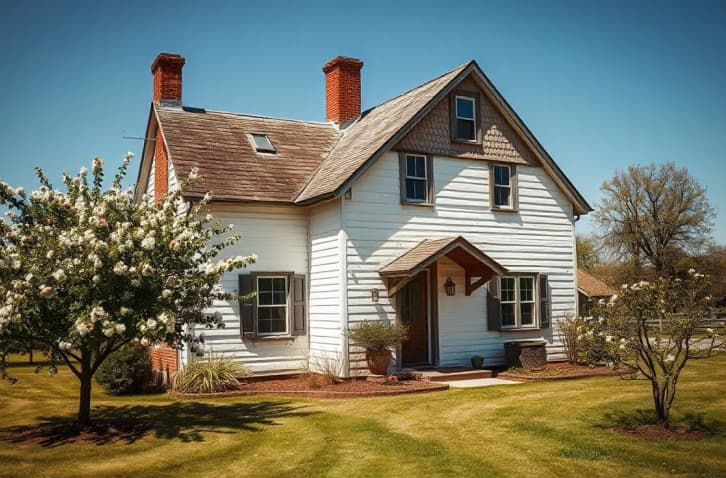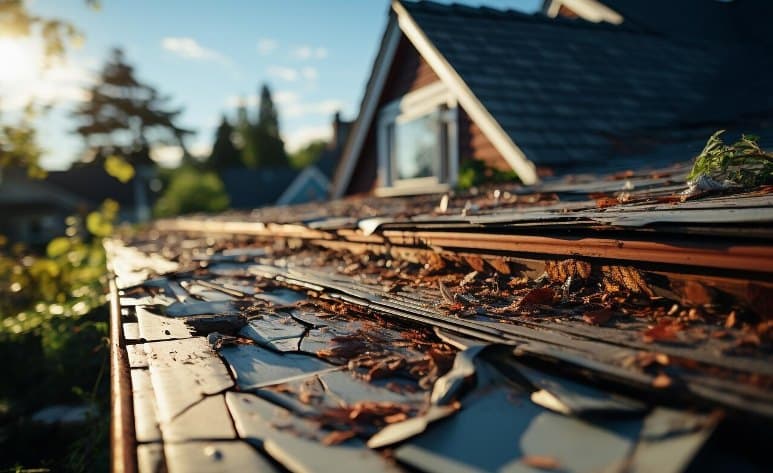Buying a home is a significant investment, and every part of the property plays a role in its value, safety, and long-term maintenance costs. One major concern for many homebuyers is the condition of the roof.
An old or aging roof can lead to expensive repairs, potential leaks, and even structural damage if not properly maintained. But does it imply you should back out of a contract just because the roof is old? Not necessarily.
Before making a decision, it’s essential to consider factors such as the roof’s age, current condition, potential repair costs, and whether the seller is willing to negotiate.
Signs of an Aging Roof
Before deciding whether to purchase a home with an old roof, it’s essential to identify the signs of wear and tear. Here are some indicators that the roof may need attention:
- Curled or Missing Shingles: If shingles are curling, buckling, or missing entirely, this can lead to water infiltration.
- Granules in Gutters: The presence of shingle granules in the gutters may indicate that the roof is nearing the end of its lifespan.
- Water Stains: Interior water stains on ceilings or walls suggest possible leaks from the roof.
- Moss or Algae Growth: Moss and algae are not immediately dangerous, but they can hold moisture and cause roof damage.
- Sagging Roof: A sagging roof can be a sign of structural issues or rotting in the underlying materials.
Evaluating the Roof’s Lifespan
Roofs are typically constructed from various materials, each with its lifespan:
- Asphalt Shingles: 15-30 years
- Metal Roofs: 40-70 years
- Tile Roofs: 50+ years
- Wood Shingles: 20-25 years
Purchasing a property with an old roof might be made more prudent if you are aware of the roofing material’s anticipated lifespan.
Possible Hazards of Buying a House with an Old Roof
Purchasing a home with an aging roof can present several risks, both financial and structural. Here are some key risks to consider:
1. Structural Damage and Leaks
An old roof is more prone to leaks, which can cause extensive water damage to ceilings, walls, and insulation. Over time, this moisture can lead to mold growth, wood rot, and weakened structural integrity.
If left unaddressed, these issues can result in expensive repairs or even compromise the safety of the home.
2. Higher Maintenance and Replacement Costs
Older roofs typically require more frequent repairs to address missing shingles, damaged flashing, or deteriorating underlayment. If the roof is near the end of its lifespan, a full replacement may be necessary soon after purchasing the home, which can be a significant financial burden.
The cost of replacing a roof varies depending on materials, labor, and location but can range from several thousand to tens of thousands of dollars.
3. Insurance and Loan Challenges
Home insurance companies may refuse coverage or charge higher premiums for homes with aging roofs, especially if they are past a certain age or in poor condition.
Additionally, mortgage lenders may require roof repairs or replacements before approving a loan, which can delay the home-buying process or increase upfront expenses.
4. Energy Efficiency Concerns
Older roofs may lack modern insulation and ventilation, leading to higher energy costs. Poor roof insulation allows heat to escape during winter and traps heat inside during summer, making heating and cooling systems work harder.
This inefficiency can result in increased utility bills and a less comfortable living environment.
5. Resale Value and Marketability
An old roof may turn off potential buyers or lower the home’s resale value if you decide to sell it in the future. Many buyers are unwilling to take on the cost and hassle of replacing a roof, leading to lower offers or extended time on the market.
6. Hidden Issues and Unexpected Expenses
An old roof might mask hidden problems, such as damaged decking, compromised attic insulation, or pest infestations. Repairing these underlying issues can add unexpected costs after moving in, making it crucial to get a thorough roof inspection before purchasing.
Negotiating the Purchase of a Home with an Old Roof
When considering a home with an aging roof, negotiation becomes a critical step in securing a fair deal. Buyers should approach the situation strategically, armed with knowledge of the roof’s condition and the potential costs involved. Here are some key points to consider when negotiating:
Get a Professional Roof Inspection
Before beginning negotiations, hire a certified roofing professional to conduct a thorough inspection of the roof. A detailed report will outline the roof’s condition, expected lifespan, and any existing damage. This report can serve as a bargaining tool when discussing price reductions or repairs with the seller.
Recognize the Roof’s Remaining Lifespan
Knowing how many years are left on the roof’s life expectancy will help guide your negotiations. If the roof is nearing the end of its useful life (usually 20 to 30 years for most materials), you may want to request that the seller replace it before closing or lower the price to reflect the anticipated cost of a replacement.
Use the Repair or Replacement Costs as Leverage
Roof replacement can be expensive, with prices ranging from $5,000 to $15,000 or more depending on the size of the home, roofing material, and labor costs.
Use this as leverage in negotiations to ask for a reduction in the asking price or to have the seller cover some or all of the repair costs. If a replacement is needed soon, you may want to request a price reduction equal to or greater than the expected cost of the work.
Negotiate for Seller-Contributed Repairs or Credit
If the seller is unwilling to lower the price, consider asking for seller-paid repairs or a credit at closing to cover the cost of replacing or repairing the roof.
The credit can be applied directly to the home’s final price or used to fund the repairs after the sale. If the seller is hesitant to handle repairs directly, offering a credit is often a more agreeable solution.
Consider an Extended Inspection Contingency
An extended inspection contingency allows you extra time to assess the roof’s condition more thoroughly and secure estimates for repairs or replacement.
If the inspection reveals significant issues, you can renegotiate the deal, ask for repairs, or even back out of the purchase without losing your earnest money.
Explore Financing Options for Roof Repairs
If the roof is in relatively good condition but needs some repairs, consider asking the seller to finance the cost of repairs as part of the sale.
Alternatively, you can explore other financing options, such as a renovation loan or a home Equity Line Of Credit (HELOC), to help cover the cost of replacing or repairing the roof after closing.
Be Prepared to Walk Away
If the seller is unwilling to negotiate, and the cost of the roof repair or replacement is prohibitively high, be prepared to walk away from the deal.
A home with an old roof might not be worth the investment if it’s going to require too much money and time to make it livable. It’s important to be realistic about your budget and the potential risks of taking on an expensive roof replacement after purchase.
When Buying a House with an Old Roof Makes Sense
Here are some scenarios where buying a house with an aging roof might be a good decision:
The Home is Priced Below Market Value
If the home is priced significantly lower than comparable properties in the area, it may make sense to buy it even with an old roof.
A lower purchase price could give you the financial flexibility to replace or repair the roof and still come out ahead in terms of the overall investment.
If you have room in your budget for future roof repairs, this could be a great opportunity to get into a desirable neighborhood at a discount.
You’re Willing to Make the Repairs or Replacement
If you’re a homeowner who is willing to invest time and money into replacing or repairing the roof, an old roof may not be a dealbreaker.
If you have experience with home improvement or the ability to hire professionals at a reasonable price, the cost of replacing the roof could be manageable.
In this case, buying a home with an aging roof allows you to customize the roof’s design and materials to your preferences.
You’re Buying a Fixer-Upper for Investment
For buyers looking to purchase a fixer-upper for resale or rental, an old roof may not be an obstacle but rather part of the overall renovation project.
If the home’s location is ideal and the structure is solid, the cost of roof replacement can be factored into the overall investment plan. Renovators can often recoup roof replacement costs by increasing the home’s resale value once the property is fully updated.
You’re Negotiating Significant Savings
In situations where the seller is motivated to sell quickly, you may be able to negotiate a substantial price reduction based on the condition of the roof.
If the seller agrees to a price reduction that adequately accounts for the cost of roof repairs, buying the house could be a good financial decision, especially if other aspects of the property — such as location, size, or potential for improvement — make it a desirable purchase.
The Roof Has Been Well-Maintained
Not all old roofs are in poor condition. If the roof has been well-maintained throughout its lifespan, it may have many years left before it requires replacement.
A roof that’s older but still in good condition, with no leaks or visible damage, could offer more value than a roof that’s been poorly maintained.
A professional inspection will help determine if an older roof can still serve its purpose for several more years without significant repairs.
The Home’s Location and Other Features Make It Irresistible
Sometimes the location, charm, or unique features of a property make it an ideal choice despite the condition of the roof. If the home is in a prime area or offers rare qualities, such as historical value, large lot size, or scenic views, an old roof may be a minor concern compared to the overall appeal of the home.
In this case, the long-term value of the property could outweigh the immediate costs of a roof replacement.
Conclusion
Deciding whether to buy a house with an old roof is a multifaceted decision that requires careful consideration. Weighing the risks, costs, and potential repairs is essential for making an informed choice.
Ultimately, a thorough inspection and knowledge of the roof’s condition will help guide your decision, ensuring you invest wisely in your future home.

